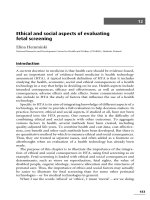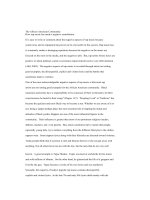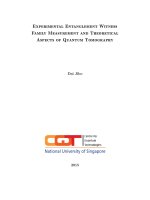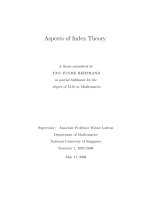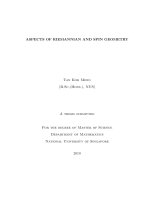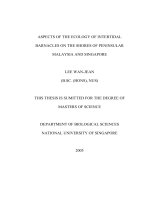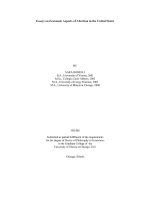Aspects of connected speech
Bạn đang xem bản rút gọn của tài liệu. Xem và tải ngay bản đầy đủ của tài liệu tại đây (102.75 KB, 27 trang )
Lecture 6
Aspects of connected speech
• Rhythm
• Assimilation
• Elision
• Linking
1
Rhythm
•
Rhythm is the relatively equal beat between stressed
syllables. It has often been claimed that English
speech is rhythmical and that rhythm is detectable in
the regular occurrence of stressed syllables.
•
The theory that English has stress-timed rhythm
implies that stressed syllables will tend to occur at
relatively regular intervals whether they are separated
by unstressed syllables or not. E.g.
Walk down the path to the end of the canal
2
• The stress-timed rhythm theory states that the time
from each stressed syllable to the next will tend to be
the same, irrespective of the number of intervening
unstressed syllables.
How did you manage to be there in time?
• In languages which have syllable-timed rhythm, all
syllables, whether stressed or unstressed tend to occur
at regular intervals of time, and the time between
stressed syllables will be shorter or longer in proportion
to the number of unstressed syllables.
3
Stress group
• A stressed syllable, together with any unstressed
syllables which may follow it form a stress group.
• The fundamental rule of English rhythm is that each
stress group within a word group is given the same
amount of time.
My teacher’s in London this Friday for a conference in
Phonetics
When did you hear the story about John and the girl
upstairs?
4
Rhythm unit (Foot)
•
A unit with a stressed syllable as its centre and any
unstressed syllables which may come before and after it
is called a rhythm unit. The rules are as follows.
1.
Any unstressed syllable at the beginning of a word
group must go together with the following stress group.
My apologies
2.
The teacher has arrived
If the unstressed syllable is part of the same word as
the stressed syllable, they belong to the same foot.
I’m going home today for Christmas
5
3. If the unstressed syllable is closely connected
grammatically to othe stressed word, although not a
part of that word, they belong to the same rhythm unit.
Give it to John
4. Whenever you are in doubt as to which rhythm unit
unstressed syllables belong to, put them after a
stressed syllable, rather than before it.
He was older than me
6
Assimilation
1.
Definition: Assimilation is the process which takes
place when one sound adapts itself to become similar
to a neighbouring sound in one or more aspects. In
other words, assimilation is the influence of one
phoneme upon another neighbouring phoneme, so that
they become more alike.
•
Assimilation may occur across word boundaries or
between words, across morpheme boundaries or within
a morpheme or a word. E.g.
light blue
good girl
cats
beds
bent
bank
7
2. Kinds of assimilation across word boundaries
a.
In terms of the direction of change
•
Regressive assimilation: Cf → Ci
•
Progressive assimilation: Ci → Cf
a.
In terms of the way in which phonemes change
•
Assimilation of place: Cf → Ci
•
Assimilation of manner: Cf → Ci
•
Assimilation of voice: Cf → Ci
8
Assimilation of place of articulation
1. Alveolar + bilabial bilabial
a. / t / becomes [ p ] before bilabials
•
right place []
•
might put []
•
might make []
•
white bird []
•
might buy []
•
might win []
9
b. / d / becomes [ b ] before bilabials
•
hard path []
•
should put [t]
•
should make []
•
good boy []
•
should win []
•
should buy []
10
c. / n / becomes [ m ] before bilabials.
•
gone past []
•
seen Peter []
•
seen Bill [
•
ten men []
•
seen Mike []
•
seen Walter []
11
2. Alveolar + velar velar
a. / t / becomes [ k ] before / k / and / g /
•
white coat []
•
might come []
•
that girl [l]
•
might go []
12
b. / d / becomes [ g ] before / k / and / g /
•
bad cold []
•
should come []
•
bad gate []
•
should go []
13
c. / n / becomes [ ] before / k / and / g /
•
one cup []
•
seen Karen []
•
main gate []
•
seen Greg []
14
3. Alveolar + dental dentalized
•
Get there []
•
tenth []
•
bad thing []
15
4. Alveolar + palato-alveolar or palatal palatoalveolar
a. / s / becomes [ ] before / / or / /
•
nice shoes []
•
this shop []
•
this year []
b. / z / becomes [ ] before / / or / /
•
those shops []
•
these sheep []
•
where’s yours []
16
c. Alveolar stops and a following / j / may merge
to form an affricate.
•
want you []
•
individual []
•
did you? []
•
education []
17
Assimilation of manner of articulation
1. Plosive + fricative fricative
•
/ t / + / s / / s / : that side []
•
/ t / + / z / / z / : that zoo []
•
/ d / + / s / / s / : good song []
•
/ d / + / z / / z / : bad zone []
2. Plosive + nasal nasal
•
/ t / + / n / / n / : that night [t]
•
/ d / + / n / / n / : good night []
18
Assimilation of voicing
• Cf (Lenis) + Ci (Fortis) Cf becomes devoiced
• Have to []
• bad tongue []
• big car []
19
Elision
1.
Definition: Elision is the disappearance of sounds in
speech. Under certain circumstances, sounds
disappear. A phoneme may be realized as zero or
have zero realization.
2.
Rules for elision
a.
Aspirated stops + weak vowel / / aspirated
stops
•
Today []
•
potatoes []
20
b. Weak vowel / / disappears before syllabic
consonants / n, l, r /
•
Canal []
•
correct []
•
connect []
c.
Stop + (stop) + stop
•
looked back [']
•
stopped killing [']
d. Stop + (stop) + fricative
•
Acts [']
•
scripts [']
21
e. Fricative + (stop) + fricative
•
Desks [']
•
guests [']
•
crisps [']
f.
/ -st / + stop, nasal, fricative / -s /
•
last time []
•
last man [n]
•
last song [l]
22
g. / -ft / + stop, nasal, fricative / -f /
•
left door []
•
left knee [i]
•
left shoe []
h. / -nd / + lenis stop, nasal / -n /
•
kind nurse []
•
canned bacon []
23
i.
/ -md / + lenis stop, nasal, / -m /
•
skimmed milk []
•
seemed good []
j.
Loss of final / v / in OF + consonant
•
Lots of them []
•
Waste of money []
24
Linking
1. Linking final consonant to initial vowel
•
Drink a cup of tea []
•
Put it on []
2. Liking identical consonants
•
Bad dog []
•
stop pushing []
•
big girl []
•
good deal []
•
this seat []
•
felt tired []
25
